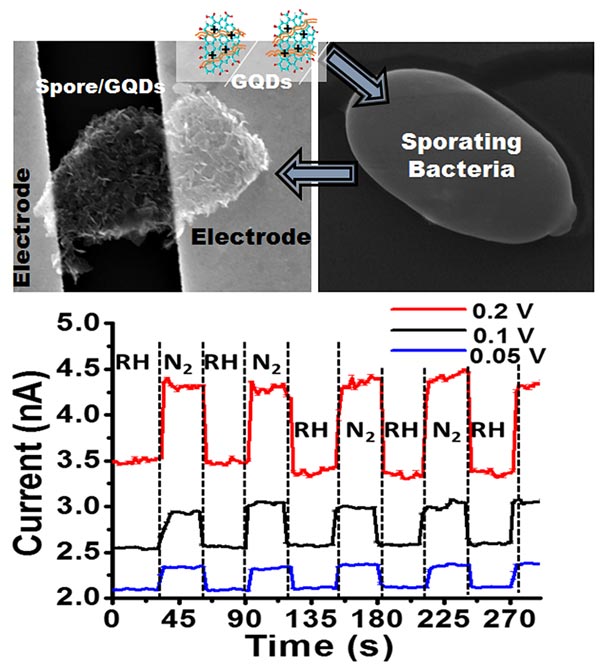Tiny Bio-Robot Is a Germ Suited-Up with Graphene Quantum Dots

Credit: Berry Research Laboratory at UIC Graphene quantum dots deposited on a sporating bacteria produces a graphene coated spore. Upon attachment of electrodes across the cell, a bio-electronic device is produced that is highly sensitive to humidity. Here, the spore reacts actively to humidity; and the reaction is translated to an electronic response from the interfaced graphene quantum dots.
Like other first-generation bio-robots, the new nanobot engineered at the University of Illinois at Chicago is a far cry from Robocop. It's a robotic germ.
UIC researchers created an electromechanical device—a humidity sensor—on a bacterial spore. They call it NERD, for Nano-Electro-Robotic Device. The report is online at Scientific Reports, a Nature open access journal.
“We’ve taken a spore from a bacteria, and put graphene quantum dots on its surface—and then attached two electrodes on either side of the spore,” said Vikas Berry, UIC associate professor of chemical engineering and principal investigator on the study.
“Then we change the humidity around the spore,” he said.
When the humidity drops, the spore shrinks as water is pushed out. As it shrinks, the quantum dots come closer together, increasing their conductivity, as measured by the electrodes.
“We get a very clean response—a very sharp change the moment we change humidity,” Berry said. The response was 10 times faster, he said, than a sensor made with the most advanced man-made water-absorbing polymers.
There was also better sensitivity in extreme low-pressure, low-humidity situations.
“We can go all the way down to a vacuum and see a response,” said Berry, which is important in applications where humidity must be kept low, for example, to prevent corrosion or food spoilage. “It’s also important in space applications, where any change in humidity could signal a leak,” he said.
Currently available sensors increase in sensitivity as humidity rises, Berry said. NERD's sensitivity is actually higher at low humidity.
“This is a fascinating device,” Berry said. “Here we have a biological entity. We’ve made the sensor on the surface of these spores, with the spore a very active complement to this device. The biological complement is actually working towards responding to stimuli and providing information.”
T. S. Sreeprasad and Phong Nguyen of UIC were lead co-authors on the study. Sreeprasad, a postdoctoral fellow, is now at Rice University in Houston. Ahmed Alshogeathri, Luke Hibbeler, Fabian Martinez and Nolan McNeiland, undergraduate students from Kansas State University, were also co-authors on the paper.
The study was supported by the Terry C. Johnson Center for Basic Cancer Research and partial support from the National Science Foundation (CMMI-1054877, CMMI-0939523 and CMMI-1030963) and the Office of Naval Research (N000141110767).
Contact Information
Jeanne Galatzer-Levy
Associate Director, News Bureau
jgala@uic.edu
Phone: 312-996-1583
Media Contact
More Information:
http://www.uic.eduAll latest news from the category: Physics and Astronomy
This area deals with the fundamental laws and building blocks of nature and how they interact, the properties and the behavior of matter, and research into space and time and their structures.
innovations-report provides in-depth reports and articles on subjects such as astrophysics, laser technologies, nuclear, quantum, particle and solid-state physics, nanotechnologies, planetary research and findings (Mars, Venus) and developments related to the Hubble Telescope.
Newest articles

Properties of new materials for microchips
… can now be measured well. Reseachers of Delft University of Technology demonstrated measuring performance properties of ultrathin silicon membranes. Making ever smaller and more powerful chips requires new ultrathin…

Floating solar’s potential
… to support sustainable development by addressing climate, water, and energy goals holistically. A new study published this week in Nature Energy raises the potential for floating solar photovoltaics (FPV)…

Skyrmions move at record speeds
… a step towards the computing of the future. An international research team led by scientists from the CNRS1 has discovered that the magnetic nanobubbles2 known as skyrmions can be…





















